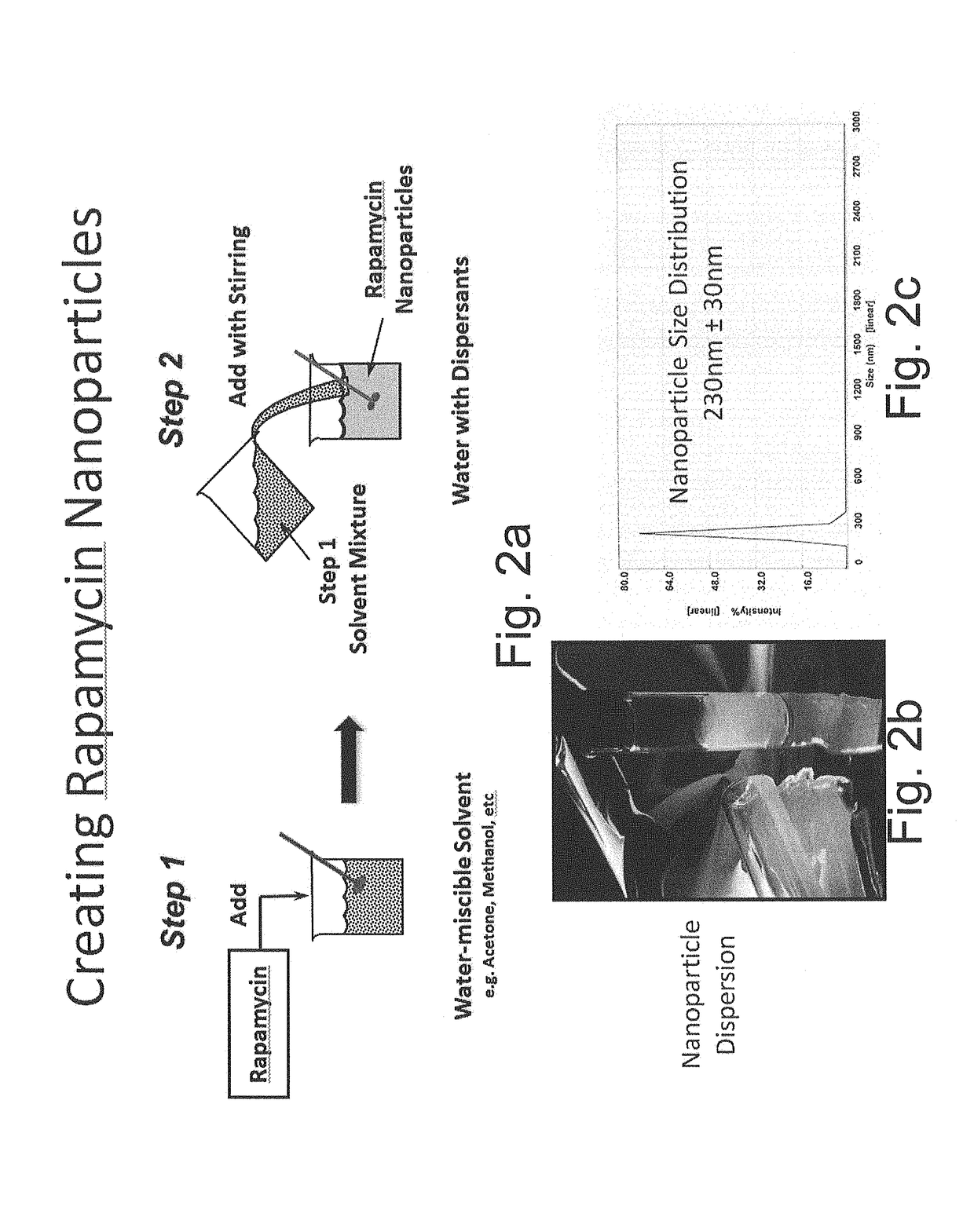Oral rapamycin nanoparticle preparations
a technology of rapamycin and nanoparticles, which is applied in the direction of nanocapsules, microcapsules, capsule delivery, etc., can solve the problems of inability to effectively use rapamycin for treating or preventing other disorders, and inability to meet the needs of patients, etc., to achieve better biodistribution, less susceptible, and more bioavailable and efficacious effects
- Summary
- Abstract
- Description
- Claims
- Application Information
AI Technical Summary
Benefits of technology
Problems solved by technology
Method used
Image
Examples
example 1
nt of Methods to Produce Rapamycin Nanoparticles
[0049]Rapid solvent exchange was used to examine the formation of rapamycin nanoparticles. Three water-miscible solvents and three water-soluble surfactants were selected to study their respective effects on the formation and morphology of rapamycin nanoparticles. The water-miscible solvents were isopropyl alcohol (Solvent 1), acetone (Solvent 2), and methanol (Solvent 3). The water-soluble surfactants were Pluronic F-68 (Dispersant 1, a non-ionic PEO-PPO-PEO block copolymer), Pluronic F-127 (Dispersant 2, a non-ionic PEO-PPO-PEO block copolymer), and sodium cholate (Dispersant 3, an anionic surfactant). Rapamycin was dissolved in each of the water-miscible solvents at a concentration of 0.25% w / v. The water-soluble surfactants were dissolved in deionized water at concentrations of 0.5% w / v, 0.5% w / v, and 1.0% w / v, respectively, for each of the dispersants. Each experimental combination (e.g. NP-1 to NP-9 in following table) consisted ...
example 2
on of a High Concentration Rapamycin Nanoparticle Dispersion
[0051]The water-miscible solvent and water-soluble dispersant of NP-9 from Example 1 was used to prepare rapamycin nanoparticles. 656 mg of rapamycin were dissolved in 6.56 mL of Solvent 3 to yield a 1.0% w / v solution. This volume of rapamycin solution was injected into 26.25 mL of 1.0% w / v Dispersant 1 in deionized water. The resulting rapamycin nanoparticle dispersion had a final rapamycin content of 2.4% w / w. The particle size of the dispersion was determined by dynamic light scattering to be 230 nm±30 nm with a single peak.
example 3
on of a Water-Soluble Enteric Coating
[0052]3.5 g of EUDRAGIT® S-100 were added to 70 mL of deionized water with light stirring, resulting in a white dispersion. 1.4 g of sodium hydroxide were added to the dispersion with continued stirring. The resulting dispersion gradually turned clear and colorless indicating an aqueous solution of S-100. The estimated concentration of sodium hydroxide was 0.5N.
PUM
| Property | Measurement | Unit |
|---|---|---|
| diameter | aaaaa | aaaaa |
| diameter | aaaaa | aaaaa |
| diameters | aaaaa | aaaaa |
Abstract
Description
Claims
Application Information
 Login to View More
Login to View More - R&D
- Intellectual Property
- Life Sciences
- Materials
- Tech Scout
- Unparalleled Data Quality
- Higher Quality Content
- 60% Fewer Hallucinations
Browse by: Latest US Patents, China's latest patents, Technical Efficacy Thesaurus, Application Domain, Technology Topic, Popular Technical Reports.
© 2025 PatSnap. All rights reserved.Legal|Privacy policy|Modern Slavery Act Transparency Statement|Sitemap|About US| Contact US: help@patsnap.com



